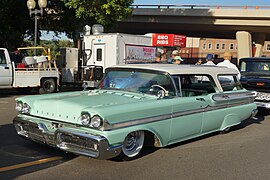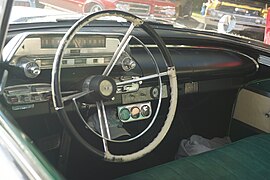
Edsel is a discontinued division and brand of automobiles that was marketed by the Ford Motor Company from the 1958 to the 1960 model years. Deriving its name from Edsel Ford, son of company founder Henry Ford, Edsels were developed in an effort to give Ford a fourth brand to gain additional market share from Chrysler and General Motors. Established as an expansion of the Lincoln-Mercury Division to three brands, Edsel shared a price range with Mercury; the division shared its bodies with both Mercury and Ford.
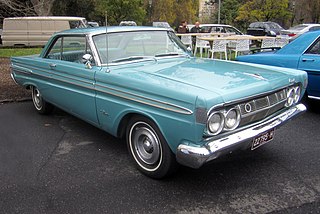
The Mercury Comet is an automobile that was produced by Mercury from 1960–1969 and 1971–1977 — variously as either a compact or an intermediate car. In its first two years, it was marketed as the "Comet" and from 1962 as the "Mercury Comet".

The Ford Galaxie is a full-sized car that was built in the United States by Ford for model years 1959 through to 1974. The name was used for the top models in Ford's full-size range from 1958 until 1961, in a marketing attempt to appeal to the excitement surrounding the Space Race. In 1958, a concept car was introduced called "la Galaxie" which incorporated the headlights into pods inline with the grille and a reduced front profile.

The Ford Parklane is a station wagon that was produced by Ford for the 1956 model year. In line with the Chevrolet Nomad, the Parklane was a premium two-door station wagon, combining the body of the two-door Ford Ranch Wagon with trim elements of the Ford Fairlane sedan.

The Ford Country Squire is a series of full-size station wagons that were assembled by American automaker Ford. Positioned as the top-level station wagon of the Ford division, the Country Squire was distinguished by woodgrain bodyside trim. From 1950 through the 1991 model years, eight generations of the Country Squire were produced. Following the discontinuation of Edsel Bermuda, Mercury marketed the Mercury Colony Park as a divisional counterpart of the Country Squire, sharing bodywork and trim while the Mercury was not available with a six cylinder engine and was more expensive due to the optional equipment on the Ford that was standard on the Mercury.

The Mercury Turnpike Cruiser is a series of automobiles that were produced by the Mercury division of Ford for the 1957 and 1958 model years. Named to commemorate the creation of the Interstate Highway System, the Turnpike Cruiser was marketed as the flagship Mercury model line, slotted above the Montclair when Mercury was positioned upmarket to luxury status when Edsel was introduced in 1958.

The Mercury Montclair is a series of full-size sedans that were manufactured and marketed by the Mercury division of Ford. The nameplate was used by the division twice, from the 1955 to the 1960 model years and from the 1964 to the 1968 model years. While not offered as a station wagon, the Montclair was offered as two-door and four-door hardtops, four-door pillared sedan, and a two-door convertible.

The Mercury Park Lane is a full-sized automobile that was produced by the Mercury division of Ford Motor Company. While not officially introduced as the replacement of the Mercury Turnpike Cruiser, the Park Lane became the flagship of the Mercury model line upon its introduction. The second-generation Park Lane was positioned above the Mercury Montclair.

The Mercury Colony Park is an American luxury full-size station wagon that was marketed by the Mercury division of Ford Motor Company between 1957 and 1991. Distinguished by its simulated wood-grain paneling, the Colony Park was marketed as either the premium-trim or the sole full-size station wagon offering of the division. Following the 1960 demise of Edsel, full-size Mercury vehicles shared bodywork with Ford; the Colony Park served as the counterpart of the Ford Country Squire through 1991.
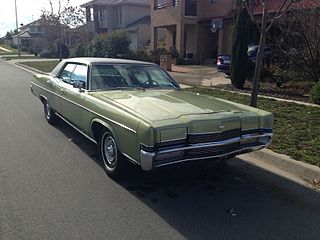
The Mercury Marquis is a model line of automobiles that was marketed by the Mercury division of Ford Motor Company from the 1967 to 1986 model years. Deriving its name from a French nobility title, the Marquis was introduced as a divisional counterpart of the Ford LTD, retaining a similar market position across four generations of the model line. Initially serving as the flagship Mercury range, the Marquis line was later expanded to include the Mercury Grand Marquis slotted above it; in various forms, Mercury would use the nameplate through the 2011 model year.

The Mercury Meteor is an automobile that was produced by Mercury from the 1961 to 1963 model years. Adopting its nameplate from the namesake Ford of Canada brand, the Meteor was introduced as the base-trim full-size Mercury sedan, while the compact Mercury Comet shared a naming convention associated with the ongoing Space Race of the early 1960s. Slotted below the Mercury Monterey, the Meteor was the Mercury counterpart of the Ford Fairlane.
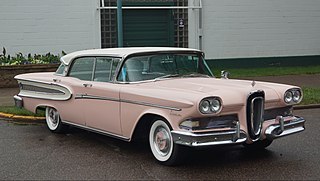
The Edsel Citation is an automobile that was produced by the Edsel division of Ford for the 1958 model year. The flagship Edsel model line, the Citation was offered as a two-door convertible; all Citation sedans were produced as hardtops. Slotted above the Corsair, the exterior of the Citation was distinguished by additional stainless steel trim and a gold-anodized aluminum cove panel.
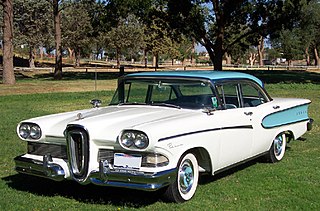
The Edsel Pacer is an automobile that was produced and sold by Edsel in 1958. The Pacer was based on the shorter narrower Edsel platform, shared with Ford and the Ranger.

The Edsel Ranger is an automobile that was produced and sold by the newly formed Edsel Division of Ford for the 1958–1960 model years. It was built on the shorter, narrower Edsel platform, shared with Ford and Edsel Pacer models.

The Ford Falcon is a model line of cars that was produced by Ford from the 1960 to 1970 model years. The first compact car marketed by the American Big Three automobile manufacturers, the Falcon was the third car line introduced by Ford, following the full-sized Ford and the Ford Thunderbird.

The 1955 Ford is an automobile which was produced by Ford in the United States for the 1955 model year and, in revised form, for the 1956 model year. A new design would be offered in 1957.
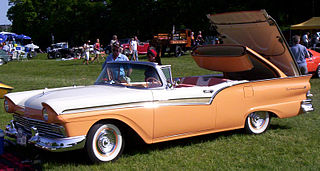
The mainstream Ford line of cars grew substantially larger for 1957, a model which lasted through 1959. The Crown Victoria with its flashy chrome "basket handle" was no more, and the acrylic glass-roofed Crown Victoria Skyliner was replaced by a new model, the retracting-roof hardtop Skyliner.
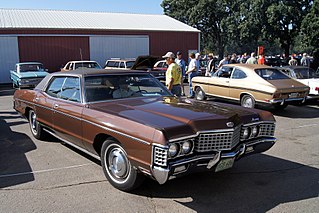
The Mercury Monterey is a series of full-size cars that were manufactured and marketed by the Mercury division of Ford from 1952 to 1974. Deriving its name from Monterey Bay, the Mercury Monterey served as the upscale version of the Mercury Custom which replaced the Mercury Eight, the debut model line of the Mercury division. During its production, the Monterey would be offered in multiple body styles, ranging from coupes, convertibles, sedans, hardtops, and station wagons.

The Mercury S-55 is a full-size car that was marketed by the Mercury division of the Ford Motor Company during the 1960s. Developed as a performance-oriented version of the mid-level Mercury Monterey, the S-55 was the largest vehicle of the Mercury "S" (Special) range introduced in 1962; its Ford equivalent was the Ford Galaxie 500XL and competed in the full-size luxury sport coupe market segment against the Chrysler 300H.

The Mercury Marauder is an automobile nameplate that was used by three distinct full-size cars produced by the Mercury division of Ford Motor Company. Deriving its name from the most powerful engines available to the Mercury line, the Marauder was marketed as the highest-performance version of the full-size product range.

